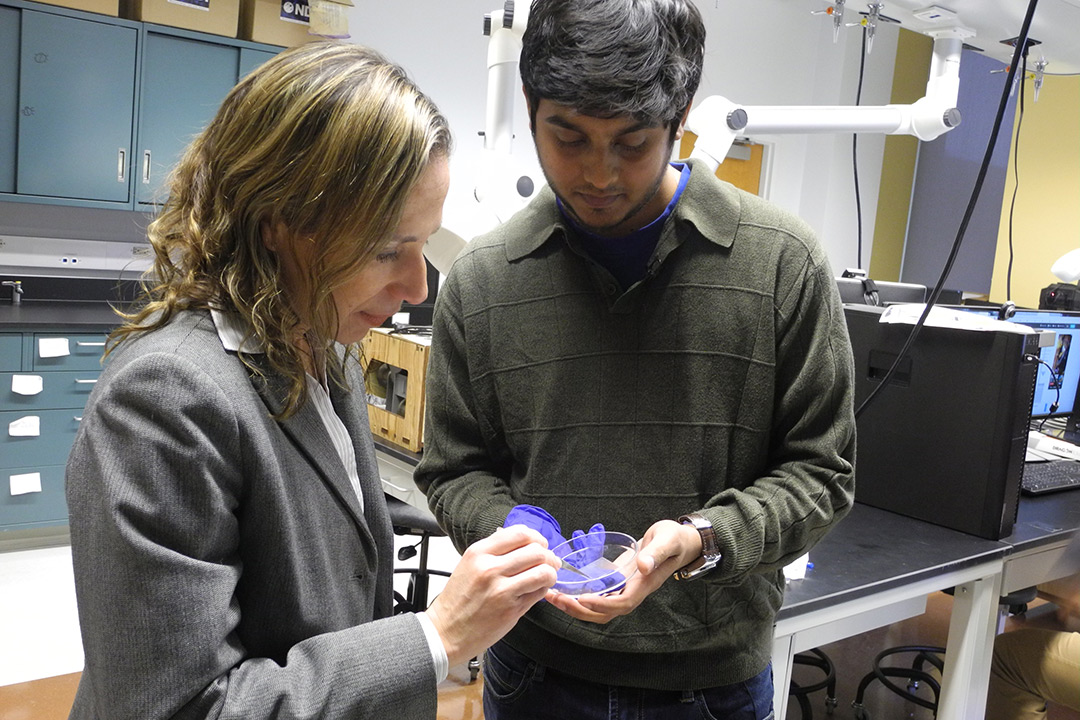RIT faculty-researcher creates 3D-printed platforms to produce bone and tissue replacements
‘Smart’ bio-printed parts can help repair the body
Michelle Cometa
Iris Rivero (left), professor of industrial and systems engineering, evaluates a 3D-printed bio-polymer structure for tissue engineering with engineering doctoral student, Srikanthan Ramesh.
New 3D printing techniques are providing a way for an RIT researcher to create platforms to help regenerate human tissue that allows the body heal itself more effectively. This work could reduce the need for human organ donations in the future.
Iris Rivero, an engineering professor at Rochester Institute of Technology, has found that compatible combinations of polymers and biomaterials can be successfully used to fabricate “scaffolds,” 3D-printed structures that signal the body to begin its own tissue regrowth. This research moves a step closer to the possibility of “smart,” 3D-printed bone, skin and cartilage tissue replacement.
“Sometimes organs in the body, due to the magnitude of damage or compromised immunology, are not able to repair themselves, and we have to come up with external alternatives to help them replace themselves,” said Rivero. “What we are seeing today is bioprinting as a technology capable of generating customized platforms that can trigger the necessary signals needed to assist the body to repair itself.”
Bioprinting uses the additive manufacturing principles of building three-dimensional parts layer-by-layer. With the advances in additive manufacturing fabrication, challenges remain in the creation of composite materials that have compatible characteristics to the human body; and, with the capability to degrade at the same rate as new tissue being formed.
For example, in tissue engineering bone, researchers add ceramic particles to biopolymers to resemble bone structure and strength. These unique combinations of biomaterials are devised for scaffold platforms and generated through controlling their processing and mixture.
“The idea is, that once we design a tissue support structure, we then create an artificial environment based on a unique biocomposite material that closely resembles tissue degradation in the body,” said Rivero, who also serves as department head of industrial and systems engineering in RIT’s Kate Gleason College of Engineering. “For skin regeneration or wound healing, you determine a particular scaffold structure to encourage skin cell proliferation. With different shapes and degrees of porosity, for example, that can serve as a smart wound dressing. In another application, when attempting to join two bones, a customized scaffold or structure can be inserted to assist in bone regeneration. To stimulate bone regeneration the scaffold can include cells that make up bone, osteoblast cells, for example and be able to accelerate the rate that tissue is being formed.”
Srikanthan Ramesh, an engineering doctoral student on Rivero’s research team, agreed, adding, “The materials we are using have similarities to collagen, a protein in the body. We use a hydrolyzed form of that protein, a gelatin. It is biocompatible – your body is already used to it – and it will not be rejected. But that is also part of the challenge we are trying to address: How are you going to make something that the body will not reject?”
Determining these answers, Rivero and Ramesh continue to evaluate different methods to achieve cell viability on the scaffolds and collaborate as part of a multi-disciplinary field that includes industrial and biomedical engineers as well as physicians, computer scientists and biologists toward bio-printing solutions.











